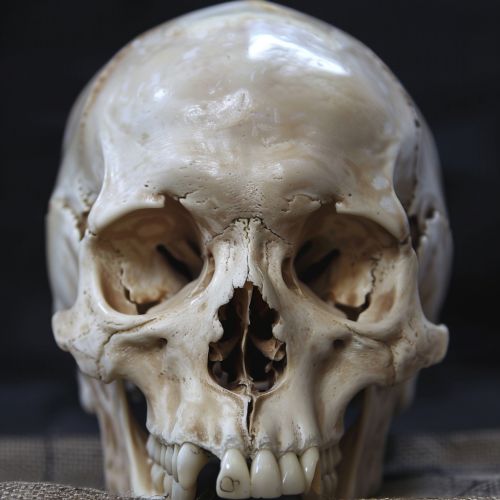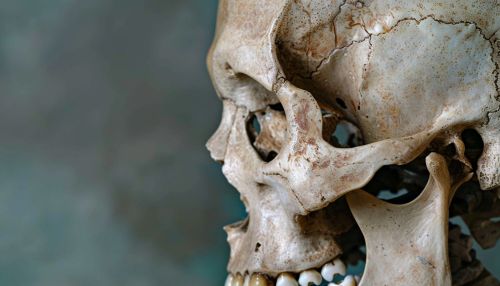Viscerocranium: Difference between revisions
(Created page with "== Anatomy of the Viscerocranium == The viscerocranium, also known as the facial skeleton or splanchnocranium, is the lower part of the skull that encompasses the facial bones. It is distinct from the neurocranium, which houses the brain and its protective coverings. The viscerocranium is primarily involved in forming the cavities for sense organs and the passages for air and food. <div class='only_on_desktop image-preview'><div clas...") |
No edit summary |
||
| (One intermediate revision by the same user not shown) | |||
| Line 3: | Line 3: | ||
The [[Viscerocranium|viscerocranium]], also known as the facial skeleton or splanchnocranium, is the lower part of the skull that encompasses the facial bones. It is distinct from the [[Neurocranium|neurocranium]], which houses the brain and its protective coverings. The viscerocranium is primarily involved in forming the cavities for sense organs and the passages for air and food. | The [[Viscerocranium|viscerocranium]], also known as the facial skeleton or splanchnocranium, is the lower part of the skull that encompasses the facial bones. It is distinct from the [[Neurocranium|neurocranium]], which houses the brain and its protective coverings. The viscerocranium is primarily involved in forming the cavities for sense organs and the passages for air and food. | ||
[[Image:Detail-79101.jpg|thumb|center|Close-up view of a human skull highlighting the viscerocranium.|class=only_on_mobile]] | |||
[[Image:Detail-79102.jpg|thumb|center|Close-up view of a human skull highlighting the viscerocranium.|class=only_on_desktop]] | |||
The viscerocranium consists of fourteen bones, which can be categorized into singular and paired bones. The singular bone is the [[Ethmoid bone|ethmoid]], while the paired bones include the [[Inferior nasal concha|inferior nasal conchae]], [[Lacrimal bone|lacrimal bones]], [[Mandible|mandibles]], [[Maxilla|maxillae]], [[Nasal bone|nasal bones]], [[Palatine bone|palatine bones]], [[Vomer|vomer]], and [[Zygomatic bone|zygomatic bones]]. | The viscerocranium consists of fourteen bones, which can be categorized into singular and paired bones. The singular bone is the [[Ethmoid bone|ethmoid]], while the paired bones include the [[Inferior nasal concha|inferior nasal conchae]], [[Lacrimal bone|lacrimal bones]], [[Mandible|mandibles]], [[Maxilla|maxillae]], [[Nasal bone|nasal bones]], [[Palatine bone|palatine bones]], [[Vomer|vomer]], and [[Zygomatic bone|zygomatic bones]]. | ||
Latest revision as of 02:42, 17 May 2024
Anatomy of the Viscerocranium
The viscerocranium, also known as the facial skeleton or splanchnocranium, is the lower part of the skull that encompasses the facial bones. It is distinct from the neurocranium, which houses the brain and its protective coverings. The viscerocranium is primarily involved in forming the cavities for sense organs and the passages for air and food.


The viscerocranium consists of fourteen bones, which can be categorized into singular and paired bones. The singular bone is the ethmoid, while the paired bones include the inferior nasal conchae, lacrimal bones, mandibles, maxillae, nasal bones, palatine bones, vomer, and zygomatic bones.
Development of the Viscerocranium
The development of the viscerocranium is a complex process that begins during embryonic development. It originates from the neural crest cells and the pharyngeal arches, which are structures that appear in the early stages of embryonic development.
The neural crest cells migrate from the dorsal neural tube to form the facial skeleton. The pharyngeal arches, on the other hand, give rise to the bones, muscles, nerves, and blood vessels of the face and neck.
Functions of the Viscerocranium
The viscerocranium serves several vital functions. It provides support and protection for the sensory organs, including the eyes, ears, and nose. It also forms the upper and lower jaws, which play a crucial role in mastication and speech.
In addition to these primary functions, the viscerocranium also contributes to the overall shape and appearance of the face. It determines facial features such as the shape of the nose, the prominence of the cheekbones, and the alignment of the teeth.
Clinical Significance of the Viscerocranium
The viscerocranium is of significant clinical interest due to its involvement in various medical conditions. For instance, fractures of the facial bones can lead to complications such as facial deformity, impaired vision, difficulty in breathing and eating, and even brain injury.
Furthermore, developmental disorders of the viscerocranium can result in conditions such as cleft lip and palate, Pierre Robin sequence, and Treacher Collins syndrome. These conditions often require surgical intervention to correct the facial deformities and improve the quality of life of the affected individuals.
